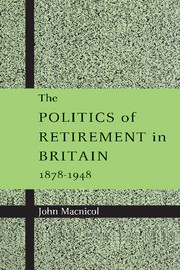Book contents
- Frontmatter
- Contents
- List of tables
- Acknowledgements
- Part I The campaign for old age pensions
- Part II Contributory pensions
- 7 The First World War and the 1919 Ryland Adkins Committee
- 8 From ‘all-in’ insurance to contributory pensions
- 9 Neville Chamberlain, the ‘New Conservatism’ and the 1925 Act
- Part III The debate on retirement pensions
- Part IV The ‘Beveridge revolution’
- Index
8 - From ‘all-in’ insurance to contributory pensions
Published online by Cambridge University Press: 01 October 2009
- Frontmatter
- Contents
- List of tables
- Acknowledgements
- Part I The campaign for old age pensions
- Part II Contributory pensions
- 7 The First World War and the 1919 Ryland Adkins Committee
- 8 From ‘all-in’ insurance to contributory pensions
- 9 Neville Chamberlain, the ‘New Conservatism’ and the 1925 Act
- Part III The debate on retirement pensions
- Part IV The ‘Beveridge revolution’
- Index
Summary
The background
The work of the Ryland Adkins Committee and the 1919 Old Age Pensions Amending Act did not in any way defuse what Bentley Gilbert has called the ‘unexploded bomb’ of the pensions issue. For in the early 1920s the question of support for the aged became tied in with much broader and politically controversial questions about the entire income maintenance system. In fact, the period 1920–4 was one of extraordinary political and civil service activity, directed at a radical overhaul of the social insurance foundations that had been laid in 1911. This, the ‘all-in’ insurance planning, aimed at the amalgamation of health and unemployment insurance into one scheme (with a single stamp and card), reform of workmen's compensation, expansion of pensions coverage (to include widows and orphans) via a new contributory scheme and – most radical of all – the introduction of a new public assistance safety-net to occupy that problematic gap between unemployment insurance and the Poor Law.
The fact that few of these plans actually materialised should not in any way detract from the enormous importance of the ‘all-in’ insurance planning. Potentially, it was one of the most important periods of social policy reform in the twentieth century. With a unique insider's perspective – based on familiarity with the subject matter but also, no doubt, on Whitehall folklore – the ex-civil servant Sir John Walley convincingly argued that the principal ‘all-in’ insurance body, the 1923–4 Anderson Committee, was far more high-powered in calibre and radical in intent than the Beveridge Committee of twenty years later.
- Type
- Chapter
- Information
- The Politics of Retirement in Britain, 1878–1948 , pp. 181 - 199Publisher: Cambridge University PressPrint publication year: 1998



